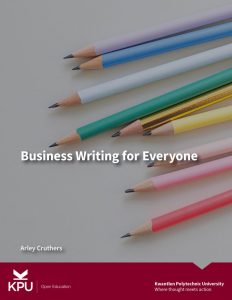Intentionally Centering Students
It’s crucial to never lose sight of who your audience is: students! As Robin DeRosa (2015) puts it, “when you use OER, you change the relationships among you, your students, and your course materials.” You’re creating this resource for their learning, growth, and development. You want to engage students in work that is meaningful to them. This means that all activities and assignments should have a purpose, which is clearly defined and explained to students. Why are students doing these assignments? How does it link to and help them achieve the learning objectives? How does it relate to the real world, their lives, and their community?

A great example of writing for students is Business Writing for Everyone by Arley Cruthers. This resource contains interactive H5P activities for students to test their learning, and activities for further reflection that instructors can use in the classroom or assign as homework. Additionally, it clearly lays out the purpose of the OER, including how to use it, and provides flexible learning opportunities for students depending on their needs.
Whatever your role in education, you can ask yourself how students and their learning is impacted with the use of OER, either positively or negatively, and determine if open resources are right for your students. What types of barriers do students in your area face? Often, OER is considered a magical tool that saves students money and works well. That said, how does the use of an online-only OER support or hinder the learning experience of a student with no access to technology (whether that be an Internet connection or reliable access to a computer)? Can you create offline formats for students? If so, will they still have the same experience? Which students in your class are more likely to struggle with these decisions, and which students are more likely to benefit from these decisions?
The open publishing projects we support not only enhance the educational experiences of students, they also help students feel seen and supported on a personal level. The goal is making your OER as impactful as possible. When we centre the student experience while designing OER, we again have an opportunity to challenge the status quo and create equitable learning environments and experiences for students.
Pause & Reflect: Intentionally Centering Students
While planning out your project, ask yourself:
- Why do you want this resource to be open?
- What do you want this resource to accomplish?
- Whose lives may be improved?
- How does your teaching impact the student experience?
- How does the selection of texts, knowledge, and assessments impact the student experience?
- Are we excluding students solely based on our own preferences for tools and techniques?
Action Plan: Involving Students
Imagine that you are an OER project team.
As you are contributing to the project as either a subject matter expert, an instructor, an instructional designer, a librarian, a student, a community member, you are wondering how in your unique role you help your team gain insight into the user perception and other feedback data needed to improve the OER you are working on? What ideas come to mind?
Resources:
DeRosa, R. (2015) The Open Syllabus: A Practical Guide to Open Pedagogy in Your Course [Slide Deck]. https://www.slideshare.net/orbitdog1/the-open-syllabus-a-practical-guide-to-open-pedagogy-in-your-course

